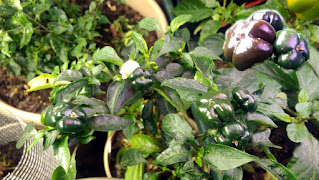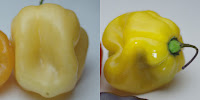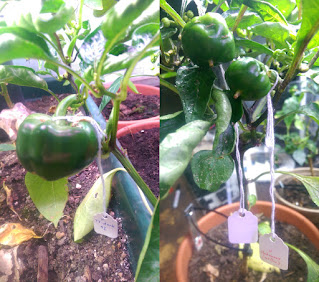Whenever I interact with a plant breeder, I first want to know what their goals are with their projects. Then I want to know about how they're approaching the problem and what results they've had so far. There are other interesting conversations to be had with breeders (What got you started in plant breeding? What got you interested in this crop? etc.), but these are the ones I keep asking when a breeder mentions their projects.
I've got a few pepper breeding projects I'm working on. I figured I'd answer my own questions regarding them, though I may ramble on a bit.
My first pepper breeding project started with a simple observation. I was growing a batch of plants from seed I had saved from a tasty small brown bell pepper I found at the grocer. One of the plants had fruit which pointed upwards. I decided I liked the look of the plant, so it was to only one I saved seed from.
The next year, I grew several plants and only found 2 of the 7 had the upright fruit posture I liked. I was disappointed, but this told be something important about the genetics of the trait. Since the female parent had the trait, but not all of the kids did, the trait didn't have a dominant inheritance. This is consistent with the description of the trait in a review of published research, indicating there are two recessive genes that interact to produce the trait.
At the end of the last growing season, I dug up the plants for this project and moved them into my basement under lights. This lets me ensure the next batch of seeds will only be from selfing the selected plants. This should help ensure the next generation of plants will all have the upright fruit trait.
This project was pretty simple to plan and is moving forward nicely. I'm hoping the plants I grow out this year will show the project is essentially complete.
I have other projects that aren't so simple, in that they will require one or more directed hybridizations. These projects will take several years to accomplish, that is if I ever complete them.
What are my breeding goals?
It took me a while to figure out what sort of peppers I might want to breed. I've got a few other projects in mind, but I figured this post was getting rather long already.
It helps to keep an open mind when working on breeding projects, since you will find variations and combinations of traits that you didn't expect from the outset. So long as you're doing the breeding project for your own purposes (as I am), there is no harm in changing direction along the way. I expect the F2s from the habanero crossed to the bell pepper to be all sorts of interesting. Even if my ideas about floral peppers never comes to fruition, something useful will come out of it.
Among pepper plants I've grown, I've already found a couple really interesting traits that have caused me to change course. I'm not willing to discuss them publicly yet. I'm still trying to decide if they're the sort of thing that would have value to a larger market, so to speak.
References:
I've got a few pepper breeding projects I'm working on. I figured I'd answer my own questions regarding them, though I may ramble on a bit.
 |
| Upright fruit on plant from 2nd generation. Upper-right: Overlay of fruit ripening brown. |
The next year, I grew several plants and only found 2 of the 7 had the upright fruit posture I liked. I was disappointed, but this told be something important about the genetics of the trait. Since the female parent had the trait, but not all of the kids did, the trait didn't have a dominant inheritance. This is consistent with the description of the trait in a review of published research, indicating there are two recessive genes that interact to produce the trait.
At the end of the last growing season, I dug up the plants for this project and moved them into my basement under lights. This lets me ensure the next batch of seeds will only be from selfing the selected plants. This should help ensure the next generation of plants will all have the upright fruit trait.
This project was pretty simple to plan and is moving forward nicely. I'm hoping the plants I grow out this year will show the project is essentially complete.
I have other projects that aren't so simple, in that they will require one or more directed hybridizations. These projects will take several years to accomplish, that is if I ever complete them.
What are my breeding goals?
- White Habanero: A Habanero with very little of any pigment, so appear "white".
- Black Habanero: A Habanero with high levels of anthocyanins, so appear "black".
- Fancy Jalapeno: A Jalapeno which ripens to red with brown stripes; bonus points for having dark purple marks too when ripe.
- Floral peppers: Arbitrary fruit, with large and colorful flowers. Ideally with flowers presented above leaves.
- White Habanero: A review of the
primary color genes for peppers (in an earlier post) indicates I can get a "white" chile with the genotype [y/y;c1/c1;c2/c2]. I have pale-orange (genotype [+/+;c1/c1;+/+]) and yellow (genotype [y/y;+/+;c2/c2]) habanero varieties. They both have the shape I'm looking for, so it is just the color genes I'll have to worry about. The F1 formed by crossing the two strains will be red and have the genotype [+/y;+/c1;+/c2]. Among the F2s, 1/64 should be homozygous for all three recessive traits needed to make a "white" chile.
[+;c1;+] and [y;+;c2] - All the other red/orange/yellow colors should also turn up in the F2s, so this will be an interesting cross to play with.
- There is a variety called "White Habanero", but it doesn't have the shape I think of when I think of a Habanero pepper.
- I've even thought of a name for the final variety: "Pale Horse".
- Black Habanero: I already have a "black" chile called "Pimenta da Neyde" (genotype [A;MoA;an]). It doesn't have the habanero shape, but I can cross it to a habanero for those traits. The boxy shape is dominant to the elongated shape, so the F1 should be boxy (and have some arbitrary color). Among the F2s, 1/64 should be homozygous for the three recessive traits needed to make the "black" color. 3/4s should have the boxy habanero shape, with 1/3 of those being homozygous for the dominant trait. All together, 1/192 of the F2s should have the ideal combination of traits.
- Depending on what color genes are hidden beneath the black of "Pimenta da Neyde", as well as what traits are brought to the party by the habanero, lots of other colors are likely to turn up in the F2s.
- There is also a variety called "Black Habanero", but it has neither the black color or the shape I'm looking for.
- I've also thought of a name for the final variety: "Black Death".
- Fancy Jalapeno: his concept will
take combining traits from several varieties. "Fish" has a recessive striped trait. I have a nice Jalapeno with a black top when unripe (which is probably related to sun exposure). I have a bell pepper which ripens brown because the chlorophyll isn't degraded upon ripening. "Pimenta da Neyde" has the trait to retain anthocyanin when the fruit is ripe. Getting all these traits, due to at least 6 different genes, into one plant is going to be a challenge. My plan so far is to make crosses between two pairs of the four strains. Once I've selected F2s from each cross that have their parents' traits, I'll then cross them, then select among the new F2s.
Hypothetical ripe and immature. - I don't yet have a name in mind to go with this project.
- I may give up before this project is done. We shall see.
- Floral Peppers: I have a bell pepper line with very large, white flowers. I have a pepper with relatively large intense-magenta flowers. I also have a pepper with relatively tiny, but greenish-yellow flowers. The plan is to cross each of the two colored-flower chiles to the bell pepper, then screen the resulting F2s for larger flowers with improved color. The fruit characteristics are entirely arbitrary.
 |
| [A;MoA;an] |
 |
| Floral variations. |
White Habanero: I have a mature habanero plant with yellow fruit. I am about to plant seeds for the one pale-orange fruit. Later in the season I'll be able to do the initial cross.
Left: Chile with magenta flowers crossed to bell.
Right: Chile with greenish flowers crossed to bell.- Black Habanero: I have a mature habanero. I have several plants of "Pimenta da Neyde", but they're all very slow growers and have yet to flower. Hopefully later in the season I'll be able to do the initial cross with them.
- Fancy Jalapeno: I have got basically nothing done towards this goal. I have all the seeds and will be planting them shortly.
- Floral Peppers: I've made each of the initial crosses between the chiles with colored flowers and the bell pepper with extra-large white flowers.
It took me a while to figure out what sort of peppers I might want to breed. I've got a few other projects in mind, but I figured this post was getting rather long already.
It helps to keep an open mind when working on breeding projects, since you will find variations and combinations of traits that you didn't expect from the outset. So long as you're doing the breeding project for your own purposes (as I am), there is no harm in changing direction along the way. I expect the F2s from the habanero crossed to the bell pepper to be all sorts of interesting. Even if my ideas about floral peppers never comes to fruition, something useful will come out of it.
Among pepper plants I've grown, I've already found a couple really interesting traits that have caused me to change course. I'm not willing to discuss them publicly yet. I'm still trying to decide if they're the sort of thing that would have value to a larger market, so to speak.
References:
- Selfing chiles: growingfoodsavingseeds.blogspot.com/2016/06/gluing-chilli-flowers-way-to-save-pure.html
- Chile genes: hortsci.ashspublications.org/content/41/5/1169.full.pdf
- Chile colors: the-biologist-is-in.blogspot.ca/2015/11/the-color-of-peppers-2.html
- Varieties:
- Pimenta da Neyde: www.fatalii.net/Articles/Pimenta-da-Neyde
- White Habanero: www.worldshottestgarlicpepper.com/white-habanero.php
- Black Habanero: www.superhotchiles.com/blackhabanerogallery.html
- Fish: www.rareseeds.com/fish-pepper/